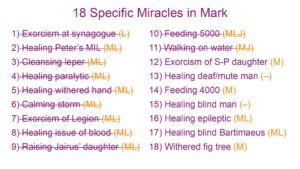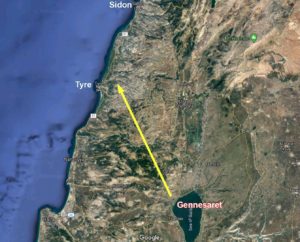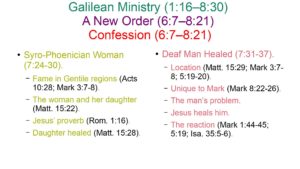The Ministry of Jesus in Galilee
Mark 1:16—8:30
A New King (1:16—3:6).
Kingdom is Near (1:15)
Popularity (1:16-45).
Conflict (2:1—3:6).
Jewish Leaders Reject Him (3:6)
A New Kingdom (3:7—6:6)
Kingdom Has Small Beginnings (4:3)
Continued Conflict (3:7-35).
Parables (4:1-34).
Identity (4:36—6:6).
Jesus’ Town Rejects Him (6:6)
A New Order (6:7—8:21)
Herod & Pharisees (8:15)
Confession (6:7—8:21).
Limited Commission (6:7-13).
John the Baptist Executed (6:14-29).
Five Thousand Fed (6:30-44).
Opposing Pharisaic Traditions (7:1-23).
Syro-Phoenician Woman (7:24-30).

Fame in Gentile regions.
As if to underscore the purification of all things and the bucking of man-made traditions, Jesus goes to the Gentile region of Tyre and Sidon (and later to Decapolis).
We see the huge divide between Jews and Gentiles, not only with the washing of items purchased from a Gentile market, but from not even keeping company with one from another nation (cf. Acts 10:28).
This is the country of Phoenicia, and the Roman province of Syria.
We know His fame had already reached this area (Mark 3:7-8).
It is evident here when He could not be hidden.
Despite trying to stay hidden and wanting to be alone, He was a servant.
Recall, this is one of the main themes of Mark, the servanthood of Jesus.
Demon-possession had affected Gentiles along with Jews.
In Mark 5, we saw the Gentile man possessed with Legion, but this happened even as far away as Phoenicia.
Mark makes it a point to emphasize this woman’s ethnic background—a Greek and a Syro-Phoenician by birth.
This means she was Greek-speaking and from that area. Matthew says she was a Canaanite, as Phoenicians were descended from those Canaanites of old (Matt. 15:22).
Mark’s primary audience, the Romans, would have better understood that she was Syro-Phoenician while Matthew’s Jewish primary audience would better understand the Canaanite distinction.
As any woman would, she loved her daughter and was willing to come to Jesus for a healing even though she was not Jewish (a Canaanite even).
We don’t know the details of this little girl’s possession, but based on others, it could not have been pleasant.
Some people have criticized Jesus’ response here as being racist against Gentiles. Before we get into it, what do you think? Was Jesus being racist?
Our gut reaction is to say, “Certainly not!” To many of us, the idea is repugnant and antithetical to what we know of Jesus’ message of love for all.
In fact, there are plenty of counter-examples showing that He wasn’t racist. What are some of those examples? The conversation with the Samaritan woman in John 4, and the Parable of the Good Samaritan in Luke 10, and healing of the centurion’s servant in Matt 8 are three.
Regardless, you might feel insulted if you were just compared to a dog.
Dogs were how many of the Jews viewed Gentiles back then, and they meant it in a derogatory way.
The form this takes, however, is diminutive, referring more to a pet than a to street or farm dog. These are like lap dogs or house dogs.
That could still be considered insulting, however, it is clear Jesus is using this in a proverbial sense. One commentator gave a good illustration on that: Say I were to ask your advice on if I should bring up a touchy subject with my wife. Your response might be, “Let sleeping dogs lie.” I know what you mean and that you’re not calling my wife a dog.
This is further evidenced by the woman’s response by extending the proverb.
The children were likened to the Jews and the dogs were the Gentiles.
She recognized, however, that the dogs were able to eat table scraps, showing her faith.
And certainly some Gentiles had already benefited from His miraculous work.
Since Jesus clearly had no objection to healing Gentiles, why do you suppose He was reluctant here? He was testing the woman’s faith.
He was ultimately showing that He was not for the Jews alone, but the Jews first and that His mission was for all mankind (cf. Rom. 1:16).
Daughter healed.
Because of her great faith, Jesus healed her daughter (Matt. 15:28).
He did this from afar, only one of eight times this occurred, and the only time in Mark.
She came home and found her daughter lying there. She likely convulsed as the others did when the demon left her, so she is lying on the bed recovering.
From this we learn that Jesus is not for the Jews only, but for the Gentiles, too.
We see this even more as He moves on into Decapolis once again.


